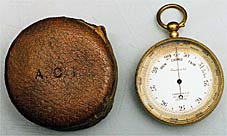
 |

![]()
By BARBARA GODFREY
HIS DAUGHTER
Robert Alexander Frazer, DSc, FRS – or Alec, as he was always known to his family – was born on February 5, 1891, at the London Institution in Finsbury Circus, where his father, Robert Watson Frazer, was principal secretary and librarian. He had two elder sisters, Kathleen, who as a young woman became a Roman Catholic and went into a Carmelite Convent at Golders Green, London, and May. Their mother, Hannah Maria (née Wilson), who was known as Lally, died in 1917 and later that year their father married Charlotte Stanley Hughes.
Alec was a brilliant scholar at the City of London School and was the first pupil to win the new Asquith Scholarship to Cambridge, which was founded to commemorate the honour conferred on the school by the Rt Hon H H Asquith, a former pupil, in becoming Prime Minister.
Alec had already distinguished himself by winning other scholarships and awards, including an open scholarship to Pembroke College, Cambridge, in 1908. He gained a BSc first class honours degree in mathematics at London University in 1911 and later, at Cambridge, gained the distinction of becoming a senior Wrangler in the Mathematical Tripos examinations and a Raleigh Prize winner. In 1930 he gained a Doctor of Science degree at London University and in 1946 was elected a Fellow of the Royal Society. Among other honours he received during his working life was winning in 1955 the Royal Aeronautical Society’s Silver Medal (the same medal won by Spitfire designer R J Mitchell in 1927) ‘for his outstanding work in Aerodynamics over a period of many years’.
 |
|
Frazer’s entire career was spent at the National Physical Laboratory (NPL), Teddington, where he was known as Bob. He was appointed to the aeronautics section in 1914 and rose to become head of the aeronautics division until retiring in 1954. His work on rigid airships involved taking part in a number of trials, but he was fortunate not to be aboard the ill-fated R38 when it crashed over the Humber in 1921, bringing this phase of his work to an end.
When the Royal Aeronautical Society founded the R38 Memorial Prize, Frazer became its third recipient in 1925 for his essay on full-scale work on rigid airships. His greatest achievements, however, were in the field of aircraft flutter, the giant wind tunnels at the NPL playing a major part in his research, and he was joint author of a long list of papers on the subject. In the late 1940s he worked on similar problems relating to the Severn Bridge project, using wind tunnels at a disused airfield at Thurleigh, Bedfordshire.
Frazer’s mathematical genius led him particularly into the field of matrices, and it was largely he who initiated their application to engineering problems. In 1938 Elementary Matrices, which he wrote with W J Duncan and A R Collar, was published by Cambridge University Press. This became a standard textbook among applied mathematicians and engineers and has remained so ever since.
Frazer was a keen mountaineer and rock climber, his earliest ‘climb’ being as a boy round the parapet of the London Institution, where his father had to talk him down before discouraging further such attempts with a sound hiding. When he grew older, Frazer chose more suitable sites for his climbing activities, spending most of his youthful holidays in Snowdonia, later in the company of his wife and children.
 |
In 1921 Frazer was invited to join a party of young Oxford graduates on an expedition to Spitsbergen. This was the first of three trips there, the second being in 1923 just after his marriage to Alice May Gwendoline Goldie, who also worked at the NPL. The couple honeymooned in Norway – and Frazer left his bride sailing up and down the coast on a mail steamer while he went north to Spitsbergen. It was on this expedition that he came to know fellow explorer Andrew Comyn Irvine (known as Sandy), who the following year perished on Everest*. After this tragedy, Irvine’s father sent Frazer his son’s aneroid barometer (pictured here), which had been recovered from the last camp below the summit. In the 1924 expedition, Frazer acted as surveyor and leader of the central sledging party which made its way across the icy wastes to the archipelago’s remote North East Land, where a glacier was named after him. The house where he and Alice lived, and where their three children were born, was named Hinlopen after the Hinlopen Straits.
The couple’s first child was Robert Ian Findlay, born on May 27, 1925. Then came Jean Barbara, born on St Valentine’s Day, 1928, and Margaret Wendy, born on October 4, 1932.
Frazer was a Freeman of the City of London in the Worshipful Company of Gardeners, and his love of gardening found its first major expression at Hinlopen, where he created a beautiful garden – an achievement he was later to repeat in subsequent homes, notably in the five-acre grounds of Bachelors, Ockham, Surrey, where he spent the last years of his life and where he died on December 8, 1959, at the age of 68.
His widow, Alice, moved to Hayling Island in Hampshire to be near her daughter Barbara and family in about 1970. She died on September 1, 1975, aged 79.
* R A Frazer is mentioned in Julie Summers’ book Fearless on Everest: The Quest for Sandy Irvine. For more details, click here.
Robert
Godfrey | T
M Godfrey | Barbara
Godfrey | R
W Frazer
Alderney Magazine | Hayling
Islander | More
pictures | Sherlock
Holmes Gazette
© 2024 ChrisGodfrey.com